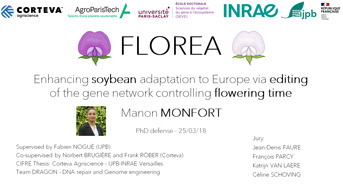Thesis defense: Manon Monfort
Tuesday, March 18th, 2 pm - INRAE, Versailles
Characterization and editing of the gene network regulating flowering in soybean to develop early varieties better adapted to cultivation in Europe
Soybean’s ability to fix atmospheric nitrogen makes it a key asset for the development of agroecology in Europe. However, as a short-day legume, soybean cultivation is geographically restricted due to its sensitivity to photoperiod. Its adaptation to long days in high-latitude regions requires early flowering. The control of flowering is regulated by a complex network of genes, which complicates traditional breeding methods. During my PhD, I employed an innovative genome-editing strategy, using CRISPR-Cas9 for multiple gene knockouts, to create allelic diversity within the genetic network regulating soybean flowering, aiming to develop early-flowering varieties. To achieve this, I selected ten flowering repressor genes for inactivation, generating soybean populations with early flowering traits. Phenotyping and genotyping results indicate the creation of allelic diversity with varying flowering times, some flowering up to four weeks earlier than controls. These findings highlight the potential of genome-editing techniques for improving soybean cultivation in Europe, enhancing food autonomy while contributing to the ecological transition.
Soybean’s ability to fix atmospheric nitrogen makes it a key asset for the development of agroecology in Europe. However, as a short-day legume, soybean cultivation is geographically restricted due to its sensitivity to photoperiod. Its adaptation to long days in high-latitude regions requires early flowering. The control of flowering is regulated by a complex network of genes, which complicates traditional breeding methods. During my PhD, I employed an innovative genome-editing strategy, using CRISPR-Cas9 for multiple gene knockouts, to create allelic diversity within the genetic network regulating soybean flowering, aiming to develop early-flowering varieties. To achieve this, I selected ten flowering repressor genes for inactivation, generating soybean populations with early flowering traits. Phenotyping and genotyping results indicate the creation of allelic diversity with varying flowering times, some flowering up to four weeks earlier than controls. These findings highlight the potential of genome-editing techniques for improving soybean cultivation in Europe, enhancing food autonomy while contributing to the ecological transition.
Director: Fabien Nogué - INRAE, IJPB, Versailles, "DNA Repair and Genome Engineering" DRAGON team
Jury members
> François Parcy (Rapporteur) - CNRS, LPCV, CEA Grenoble
> Katrijn Van Laere - (Rapportrice) - ILVO, Flanders Research Institute for Agriculture, Belgique
> Cécile Schoving (Examinateur) - INRAE, Université de Toulouse
> Jean-Denis Faure (Examinateur) - INRAE, IJPB, Versailles, AgroParisTech
Research developed at the Institute Jean-Pierre Bourgin for Plant Sciences in collaboration.
Back
